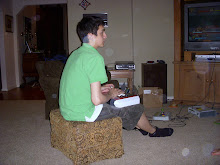After the pep talk, I went to the arcade and popped in my credit. I sat down and said to myself "You are not bad at this game. Your not the best, yet your not BAD at this game. As a matter of fact your DAMN GOOD! Now play this game to your standard!" That night I left with something like a 30 win streak. The win streak really doesn't matter, it was just the fact that the lesson was learned...whatever mindset you bring in before the match, is the same mindset you'll have during the match.
However, I want to write about exactly why I felt I had plateaued with Ryu. At the time, I had played Ryu like most of the other players who play Ryu...get the knockdown, try for a combo, and play all around solid through footsies. Now normally I can wreck people with this type of play style. Ryu's crossup is pretty good, and can be fairly ambiguous at times. However when playing better players in my area, such as Deezo or Jason Cole, I started realizing that this style of play gets nowhere. You may be asking "What the heck are you talking about!?" What I mean is that once I get a knockdown on a player who is GOOD, they are content with eating a possible throw, and merely blocking a string. When you get down to it, at low to mid level play, this style of playing is acceptable. However at top level, Ryu can't hang. Better players realize that Ryu does NOT have options after blocked strings. Compare this to the rest of the cast, for example the other 2 shoto's: Ken can use kara grab mixup after strings, and Akuma can use a demon flip or possibly s.hk to keep close. These are just quick examples, but what it really gets down to is the fact that most Ryu's do damage from combo's, and to do combo's you need to have constant pressure up close. All in all, Ryu's mixups and tricks are NOT good enough at top level play, instead a more practical and solid way of dealing out damage is needed.
A few days ago, I watched a few more Daigo videos. I swear to god, this guy is so inspiring to me as a player because I feel as if I truly understand why he does things. I almost feel as if Daigo wastes NO movement or attack at all...everything he does has a purpose. Anyways, let me jump off those nuts real quick and explain what I realized. After watching matches, I was seeing that Daigo NEVER tries to pressure his opponent like most players do. I mean, he likes to be in his opponent's face, and play them up close, however never does he try to go for a combo after a knockdown. I think out of all the videos I've seen, I have witnessed Daigo crossover with j.mk ONCE. So I had to question it "Why doesn't he pursue the knockdown and press the advantage!?" I finally came to the realization that if I were to come to the idea that Ryu isn't good enough from the inside at a certain level of play, he MUST have had this realization as well. However, unlike me, Daigo had already figured a more practical way of dealing damage instead of just combos. Why crossover and have a blocked string, when you have a more consistent way to gain damage, through baiting, setups, and reading an opponent.
The epiphany that I've come across is that: Ryu can only be played at top level ONLY when the player is an instinct player. What it comes down to is exactly what Mandel told me...2 things that I think I'll remember for a very long time: "When you don't play to a particular script or anything, and play to your opponents, Ryu becomes crazy...Thats what great Ryu's do, it feels like everything you do is wrong." Daigo is a player who plays solely off of instincts regarding his opponents. By setting his opponent up to think a certain way, he baits them into playing into his hand so he can deal out damage. At the same time, by reading his opponents, it makes it easier for him to set his opponent up. Like Mandel told me "In the end, it all comes together." By reading a players behaviors, baiting and setups become instinctual to you as a player, with setups and baiting comes damage.
So thats it, that's the huge epiphany...the fact that if I'm going to become a great Ryu player, I need to play to my opponent, not to how I want to play...but to what is best against my opponent. Thus, begins the journey to becoming an instinctual player.
- Mickey
